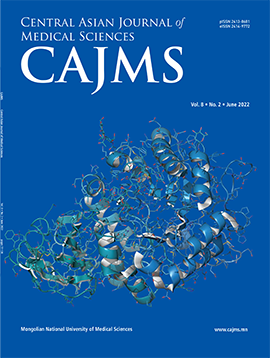Paranasal Sinuses Anatomic Variants and its Association with Chronic Rhinosinusitis in Mongolia
DOI:
https://doi.org/10.24079/cajms.2022.12.003Keywords:
Nasal Sinuses, Chronic Rhinosinusitis, Sinus Infections, Paranasal Sinuses, Anatomic VariantsAbstract
Objective: The aim of this study was to obtain the prevalence of nasosinus anatomic variations in a Mongolian population and to understand their importance and impact on the disease process, as well as their influence on surgical management and outcome. Methods: This study is a prospective review of retrospectively performed normal computed tomography (CT) scans of the nose and paranasal sinuses in the adult Mongolian population. Results: Of all CT scans that were reviewed, 53.7 % were of women patients and 46.3 % were of men patients. The mean age of the study sample was 45.6 ± 16.3 years. The most common anatomic variation after excluding Agger nasi cell was pneumatized crista galli, which was seen in 98.8 % of the scans. Anatomic variants with a potential impact on operative safety included Haller cell (13.3 %), concha bullosa (20.5 %), and paradoxical middle turbinate (27.3 %). In our study, we compared the measurements between the anterior ethmoid artery and adjacent anatomical structures in two groups. Conclusions: A wide range of regional differences in the prevalence of each anatomic variation exists. Understanding the preoperative CT scan is substantially important because it is the road map for the sinus surgeon. Detection of anatomic variations is vital for surgical planning and prevention of complications.
Downloads
245
Downloads
Published
How to Cite
Issue
Section
License
Copyright (c) 2022 Mongolian National University of Medical Sciences

This work is licensed under a Creative Commons Attribution-NonCommercial 4.0 International License.




